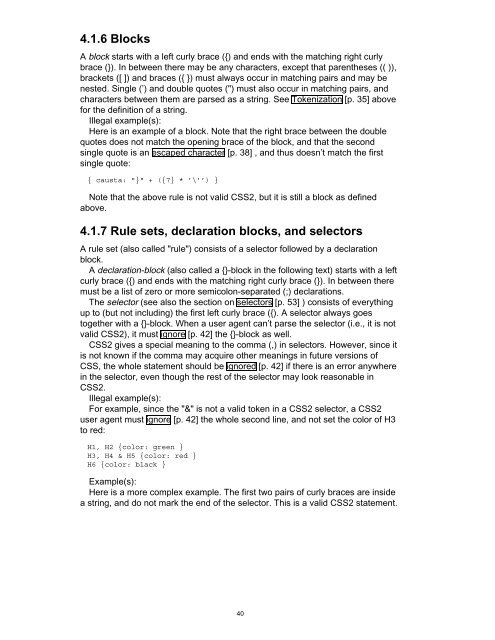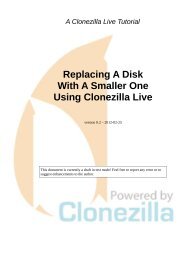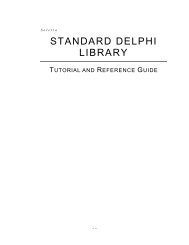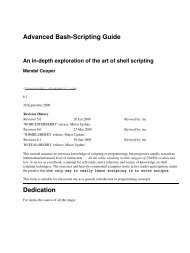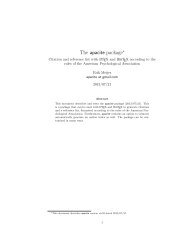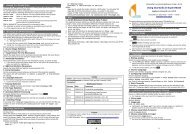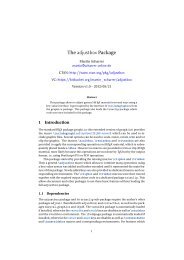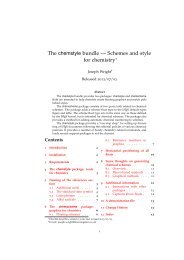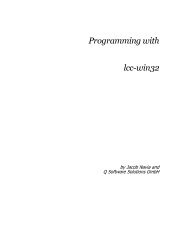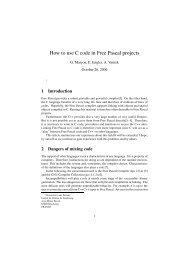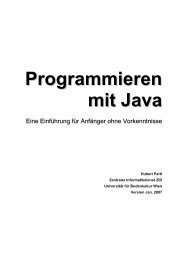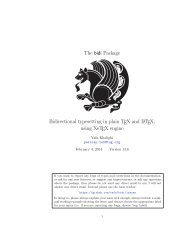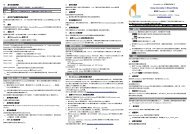- Page 1 and 2: REC-CSS2-19980512 Cascading Style S
- Page 3 and 4: Quick Table of Contents 1 About the
- Page 5 and 6: 4.3.4 URL + URN = URI . . . . . . .
- Page 7 and 8: 9.7 Relationships between ’displa
- Page 9 and 10: cursive . . . . . . . . . . . . . 2
- Page 11: B.1 New functionality . . . . . . .
- Page 14 and 15: Section 2: An introduction to CSS2
- Page 16 and 17: Initial This part specifies the pro
- Page 18 and 19: The section on Paged Media was in l
- Page 21 and 22: Contents 2 Introduction to CSS2 2.1
- Page 23 and 24: CSS2 has more than 100 different pr
- Page 25 and 26: Adding more rules to the style shee
- Page 27: Simplicity. CSS2 is more complex th
- Page 30 and 31: Document language The encoding lang
- Page 32 and 33: 3.2 Conformance This section define
- Page 35 and 36: Contents 4 CSS2 syntax and basic da
- Page 37 and 38: Macro Definition ident name nmstart
- Page 39: In fact, these two methods may be c
- Page 43 and 44: A user agent conforming to a future
- Page 45 and 46: 0.28 mm 1.4 mm viewer 28 inch 71 cm
- Page 47 and 48: Example(s): An example without quot
- Page 49 and 50: Values outside the device gamut sho
- Page 51 and 52: When a style sheet resides in a sep
- Page 53 and 54: Contents 5 Selectors 5.1 Pattern ma
- Page 55 and 56: 5.2 Selector syntax A simple select
- Page 57 and 58: 5.6 Child selectors A child selecto
- Page 59 and 60: Example(s): The following rule hide
- Page 61 and 62: H1#chapter1 { text-align: center }
- Page 63 and 64: Example(s): The following rule sets
- Page 65 and 66: 5.11.4 The language pseudo-class: :
- Page 67 and 68: The following CSS2 will make a drop
- Page 69 and 70: 6 Assigning property values, Cascad
- Page 71 and 72: BODY { font-size: 10pt } H1 { font-
- Page 73 and 74: 6.4.1 Cascading order To find the v
- Page 75: author style sheet and may be overr
- Page 78 and 79: Link to a target medium The bo
- Page 80 and 81: Relationship between media groups a
- Page 82 and 83: Top TM TB TP Margin (Transparent) B
- Page 84 and 85: First element of list Second elemen
- Page 86 and 87: Value: {1,4} | inherit Initial: not
- Page 88 and 89: values, they apply to the top, righ
- Page 90 and 91:
’border-color’ Value: {1,4} | t
- Page 92 and 93:
Since the initial value of the bord
- Page 95 and 96:
Contents 9 Visual formatting model
- Page 97 and 98:
9.2 Controlling box generation The
- Page 99 and 100:
The P generates a block box, with s
- Page 101 and 102:
The properties of the run-in elemen
- Page 103 and 104:
Value: static | relative | absolute
- Page 105 and 106:
The offset is a fixed distance from
- Page 107 and 108:
or like this: Several emphasized wo
- Page 109 and 110:
IMG { float: left } BODY, P, IMG {
- Page 111 and 112:
image margin paragraph border parag
- Page 113 and 114:
Values have the following meanings
- Page 115 and 116:
position: fixed; width: 100%; heigh
- Page 117 and 118:
Document Window (0,0) (0, 400) 1 Be
- Page 119 and 120:
Document Window (0,0) (0, 400) 24 p
- Page 121 and 122:
Document Window (0,0) (0, 400) 24 p
- Page 123 and 124:
Document Window (0,0) (0, 400) 24 p
- Page 125 and 126:
Document Window I used two red hyph
- Page 127 and 128:
This text will be beneath everythi
- Page 129 and 130:
(U+202C) at the end of the element.
- Page 131 and 132:
Contents 10 Visual formatting model
- Page 133 and 134:
#div1 { position: absolute; left: 5
- Page 135 and 136:
(If the border style is ’none’,
- Page 137 and 138:
’max-width’ Value: Initial: App
- Page 139 and 140:
10.6.1 Inline, non-replaced element
- Page 141 and 142:
Value: Initial: Applies to: | | n
- Page 143 and 144:
. We recommend a computed value for
- Page 145 and 146:
Contents 11 Visual effects 11.1 Ove
- Page 147 and 148:
DIV I didn’t like the play, but t
- Page 149 and 150:
(0, 0) (50, 0) clip region (0, 55)
- Page 151 and 152:
onclick=’show("container2");hid
- Page 153 and 154:
12 Generated content, automatic num
- Page 155 and 156:
the pseudo-element will behave as i
- Page 157 and 158:
’block’: the pseudo-element is
- Page 159 and 160:
Approximate rendering ISO 10646 cod
- Page 161 and 162:
Value: [ ? ]+ | none | inherit Ini
- Page 163 and 164:
Example(s): The following style she
- Page 165 and 166:
first or last line box exists in a
- Page 167 and 168:
This is a very short document. This
- Page 169 and 170:
decimal Decimal numbers, beginning
- Page 171 and 172:
inside The marker box is the first
- Page 173 and 174:
OL.alpha { list-style: lower-alpha
- Page 175 and 176:
Contents 13 Paged media 13.1 Introd
- Page 177 and 178:
Sheet Page box A D Page content B C
- Page 179 and 180:
13.2.3 Crop marks: the ’marks’
- Page 181 and 182:
13.3.1 Break before/after elements:
- Page 183 and 184:
Value: | inherit Initial: 2 Applie
- Page 185 and 186:
13.4 Cascading in the page context
- Page 187 and 188:
Contents 14 Colors and Backgrounds
- Page 189 and 190:
This property sets the background i
- Page 191 and 192:
User agents may treat ’fixed’ a
- Page 193 and 194:
14.3 Gamma correction For informati
- Page 195 and 196:
Contents 15 Fonts 15.1 Introduction
- Page 197 and 198:
In the CSS2 font model, as in CSS1,
- Page 199 and 200:
15.2.2 Font family: the ’font-fam
- Page 201 and 202:
normal font. italic Specifies a fon
- Page 203 and 204:
1. ultra-condensed 2. extra-condens
- Page 205 and 206:
Specifies the aspect value. The num
- Page 207 and 208:
15.2.5 Shorthand font property: the
- Page 209 and 210:
menu The font used in menus (e.g.,
- Page 211 and 212:
Latin fonts Greek fonts Cyrillic fo
- Page 213 and 214:
page can be displayed. Progressive
- Page 215 and 216:
15.3.2 Descriptors for Selecting a
- Page 217 and 218:
15.3.3 Descriptors for Font Data Qu
- Page 219 and 220:
Value: [ [format( [, ]*)] | ] [,
- Page 221 and 222:
’stemv’ (Descriptor) Value: In
- Page 223 and 224:
the extras are ignored. [p. 42] Exa
- Page 225 and 226:
Swiss 721 light Swiss 721 Swiss 721
- Page 227 and 228:
The ideal solution would be to have
- Page 229 and 230:
15.4.11 Lower Baseline This gives t
- Page 231 and 232:
15.4.19 Vertical stem width This is
- Page 233 and 234:
The per-descriptor matching rules f
- Page 235 and 236:
The next example defines a family o
- Page 237 and 238:
Contents 16 Text 16.1 Indentation:
- Page 239 and 240:
16.3.1 Underlining, overlining, str
- Page 241 and 242:
Example(s): Consider this example:
- Page 243 and 244:
This property controls capitalizati
- Page 245 and 246:
Contents 17 Tables 17.1 Introductio
- Page 247 and 248:
other document languages (such as X
- Page 249 and 250:
’table-footer-group’) element T
- Page 251 and 252:
caption’s margin caption caption
- Page 253 and 254:
current margins text text text prev
- Page 255 and 256:
cells rows row groups columns colum
- Page 257 and 258:
The two algorithms are described be
- Page 259 and 260:
percentage values of ’height’ r
- Page 261 and 262:
Long distance calls $1.30 $2.50 $10
- Page 263 and 264:
In the separated borders model, thi
- Page 265 and 266:
The following example illustrates t
- Page 267 and 268:
solid The border is a single line s
- Page 269 and 270:
224.00 90.00 379.02 Seattle 27-
- Page 271 and 272:
Contents 18 User interface 18.1 Cur
- Page 273 and 274:
CaptionText Text in caption, size b
- Page 275 and 276:
Value: | invert | inherit Initial:
- Page 277 and 278:
Contents 19 Aural style sheets 19.1
- Page 279 and 280:
Another speech browser is being use
- Page 281 and 282:
19.5 Cue properties: ’cue-before
- Page 283 and 284:
Example(s): BLOCKQUOTE.sad { play-d
- Page 285 and 286:
elow Same as ’-90deg’. level Sa
- Page 287 and 288:
Values have the following meanings:
- Page 289 and 290:
none Punctuation is not to be spoke
- Page 291 and 292:
Appendix A. A sample style sheet fo
- Page 293 and 294:
Contents Appendix B. Changes from C
- Page 295 and 296:
Appendix C. Implementation and perf
- Page 297 and 298:
Multiple Master Font A Multiple Mas
- Page 299 and 300:
C.2 Font retrieval There are many d
- Page 301 and 302:
Stroke Variation Any (0) No Fit (1)
- Page 303 and 304:
to convert the information in a Tru
- Page 305 and 306:
Block Add Block name Unicode range
- Page 307 and 308:
307
- Page 309 and 310:
Contents Appendix D. The grammar of
- Page 311 and 312:
* after the "#"; e.g., "#000" is OK
- Page 313 and 314:
Contents Appendix E. References E.1
- Page 315 and 316:
[YACC] "YACC - Yet another compiler
- Page 317 and 318:
Appendix F. Property index Name ’
- Page 319 and 320:
Name Values ’float’ [p. 111] le
- Page 321 and 322:
Name ’overflow’ [p. 145] Values
- Page 323 and 324:
Appendix G. Descriptor index Name V
- Page 325 and 326:
:active, 294, 63 :after, 153, 68 :b
- Page 327 and 328:
’border-right-width’, 88 ’bor
- Page 329 and 330:
’definition-src’ (descriptor),
- Page 331 and 332:
hiragana-iroha, 169 horizontal marg
- Page 333 and 334:
message entity, 33 ’min-height’
- Page 335 and 336:
quad width, 44 ’quotes’, 157 RE
- Page 337 and 338:
’table-header-group’, 102 ’ta


